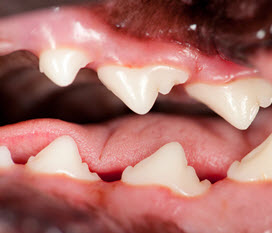Loving pet parents want their dogs to live the happiest, healthiest lives possible. Attaining optimal health includes having white, healthy teeth. Yet preventive dental care represents one of the most neglected pet health needs. To kick off Pet Dental Health Month in February, we’d like to provide a refresher on this important topic.
According to the American Veterinary Medical Association (AVMA), 80% of dogs show signs of dental health disease by the age of 3. By the age of 8, dental disease is irreversible! Why is this so important? Dental disease, or periodontal infections, have been linked to heart disease, diabetes, kidney disease, liver disease and a weakened immune system. On the flip side, studies have estimated you could extend your dog’s life for 2 ½ to 3 years by providing proper dental care.
Assessing Your Dog’s Dental Health
Just like humans, dogs are likely to get plaque buildup on their teeth. This buildup will turn to tartar when it combines with your dog’s saliva and bits of food between their teeth. Left untreated, this may lead to periodontal disease, a bacterial infection of the mouth, which can lead to gum disease and in severe cases, tooth loss. These conditions are very uncomfortable for your dog, and in many cases painful.
The most common signs of dental or oral disease are bad breath and a buildup of yellow/brown tartar on their teeth. Other signs include loose teeth, inflamed or bleeding gums (gingivitis), excessive drooling, difficulty chewing or loss of appetite. If you notice your dog has any of these signs, make an appointment with your veterinarian to get a complete periodontal examination. X-rays might be necessary to uncover issues that are not visible to you.
Proper Dental Care
Just like a daily walk, make dental care part of your dog’s health regimen. Starting while they’re still puppies may be much easier than trying to introduce brushing at a later stage in their lives.
Depending on their age, dogs should have a dental exam by their vet every 6-12 months. This would include visual and manual inspection to check for indications of tooth pain, gum disease, loose teeth or tartar and plaque buildup. If buildup is seen, you will want to schedule a teeth cleaning.
Depending on the complexity of the procedure, your dog might need to be given anesthesia to keep them comfortable during long procedures such as tooth removal or root canals. More simple cases of buildup might only require ultrasonic removal.
Brushing Your Dog’s Teeth
More and more dental care products are becoming available each year, but most veterinarians still believe that brushing their teeth is the single most important part of your dog’s oral care. If your dog goes along with daily brushing, keep it up. But for fussier dogs, many vets believe that several weekly brushings will be sufficient.
Some tips on brushing your dog’s teeth:
- Pick a time of day that can consistently work for you in your daily doggie routine. Tying it into getting a treat afterward may get him to look forward to his brushing.
- Use a soft-bristled toothbrush designed to remove plaque from under the gum line, along with veterinary toothpaste.
- Introduce the process slowly. Start by offering a taste of the toothpaste. Next time, run some toothpaste along his gums of the upper teeth with your finger. Gradually start using the toothbrush in the process.
- Start with the upper teeth and as your dog develops a greater comfort level, include the lower teeth in the routine.
Later this month we will address more doggie dental issues, but this will serve as a solid platform for getting good oral care habits started.
This blog is brought to you by Under the Weather®, provider of bland diet products for dogs. These bland diet products offer a quick and convenient solution when dogs experience digestive issues such as vomiting or diarrhea. Ready to go in minutes – just add boiling water to rehydrate.
Our bland diet recipes are made with 100% human-grade meats – no meat by-products, antibiotic free and no hormones added! They are gluten free and have no chemicals or dyes. Sourced and manufactured in the U.S.A.
View Our Products
Visit Our Blog Library





